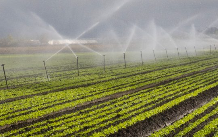Agriculture News
By: Ryan Flaming, Harvey County Extension Agent, Agriculture and Natural Resources
Current Date: 8/25/20
Sugarcane Aphid
Sugar Cane Aphids have been seen in local fields and it is time to be scouting for them. Infestations begin when swarms of winged aphids settle in a field and begin to establish colonies. Their daughters can mature in less than a week, lack wings, and have a much higher reproductive rate than their winged mothers.
Established colonies of wingless aphids quickly become large and crowded, which causes winged forms to develop, until the final generation is exclusively winged once again. Thus, the trend will be for Kansas to receive SCA only after infestations to the south mature and produce winged migrants. Growers are advised to plant sorghum as early as agronomically feasible to maximize plant growth and maturity before aphids arrive.
Sampling method
Once a week, walk 25 feet into the field and examine plants along 50 feet of row:
If honeydew (shiny, sticky substance on leaf surface) is present, look for SCA on the underside of a leaf above the honeydew.
Inspect the underside of leaves from the upper and lower canopy from 15–20 plants per location.
Sample each side of the field as well as sites near Johnson grass and tall mutant plants.
Check at least 4 locations per field for a total of 60-80 plants.
If no SCA are present, or only a few wingless/winged aphids are on upper leaves, repeat this sampling method once a week thereafter. If SCA are found on lower or mid-canopy leaves, begin twice-a-week scouting. Use the same sampling method, but be sure to include the percent of plants with honeydew. Estimate the percent of infested plants with large amounts of SCA honeydew to help time foliar insecticides for SCA control on sorghum.




